How five secondary teachers transformed their music departments using Musical Futures as a catalyst for change.
Musical Futures is a pedagogical approach that brings the real-life learning practices of popular and community musicians into school classrooms.
As Musical Futures is a non-statutory approach to teaching and learning, rather than a curriculum or programme, individual teachers and practitioners adapt and apply Musical Futures approaches in their practice in a range of ways.
This case study is an illustration, not of the theory of Musical Futures (as this is well documented and available at http://www.musicalfutures.org ), but rather about how Musical Futures has been used in a variety of ways as a catalyst for change in school music departments. It will focus on the application of Musical Futures from Year 6 to Year 13 across a range of contexts.
Each school is a Musical Futures ‘Champion’ and is part of the team that provides Musical Futures professional development in the UK and overseas.
Here is a link to a short film about the ethos of the professional development programme ( https://www.youtube.com/watch?v=Y0gES_A9SX8 ).
Abigail D’Amore (Musical Futures) and Peter Romhany (Morpeth School)
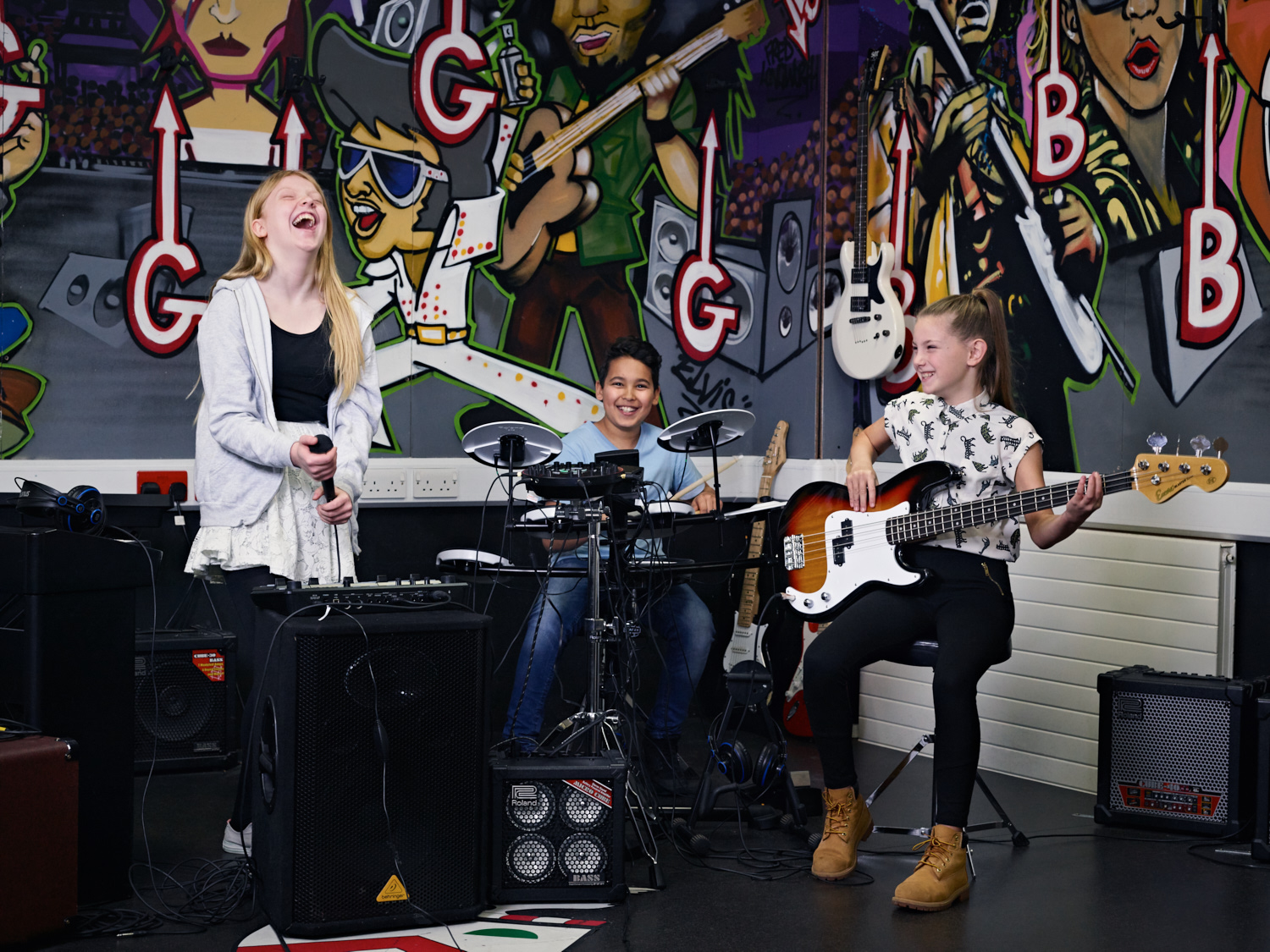
Context
Each school embeds Musical Futures across all Secondary School Key Stages and this falls into regular statutory classroom sessions.
Morpeth School, Bethnal Green, London
Morpeth School is a secondary school with nearly 1600 students situated in Bethnal Green – an ethnically diverse area that has some of the most endemic poverty in the London Borough of Tower Hamlets. Students come from a wide range of ethnic backgrounds, with those of Bangladeshi heritage forming just over half of the school’s population. The music department has been involved with Musical Futures for over 10 years, where the method acted as a catalyst for change both in the classroom and beyond.
All students participate in Musical Futures-influenced work across the Key Stages. In Years 7 and 8 (ages 11-12y) students have one hundred minutes every two weeks in class sizes of 20. There are currently 40 student taking Key Stage 4 Music, which includes GCSE Music and Rock School. At Key Stage 5, they offer A (Advanced) Level Music Technology, Btec Music Performance and Rock School Subsidiary Diploma in Music Technology. About 280 students take part in free extra-curricular instrumental tuition per week, with lessons ranging from individual to large groups as well as numerous ensemble groups.
Harrogate Grammar School, North Yorkshire
Harrogate Grammar School is an independent, coeducational school and sixth form located in Harrogate, North Yorkshire. It has 1700 pupils with approximately 600 in the Sixth form. Currently, there are 16 students taking A2 Music in Year 13 (all have carried on from Year 12), 13 students taking AS Music and with 28 students taking BTec Music Level 3.
Steyning Grammar School, West Sussex
Steyning Grammar School is a state secondary school with nearly 2000 students, including a large Sixth form, and substantial boarding provision situated in the South Downs of England near Brighton. Students come from a wide range of ethnic backgrounds due to the nature of the state boarding school provision. The music department has been involved with Musical Futures for over 5 years, where the method acted as a catalyst for change both in the classroom and beyond.

Key Stage 3 (KS3) classes are for Year 7 and 8, with students having an hour lesson every week in class sizes of 30. There are currently 140 students taking KS4 Music, which includes GCSE Music alongside RSL Music Practitioner vocational qualifications. Demand for music has grown over the last 5 years at both KS4 and for the oldest pupils in KS5. The school currently has a Sixth form with 30 students studying music, with the possibility of both A level Music and RSL Level 3 Music Practitioner. About 150 students take part in extra-curricular instrumental tuition per week, with mostly individual lessons. Outside of school, many students also take music lessons privately.
Fred Longworth High School, Wigan
Fred Longworth High School is a 11-16y converter Academy with 1300 students situated in Wigan. The school has a comprehensive intake, with students from a wide range of backgrounds. The music department became a Musical Futures (MF) Champion School in 2008, when they first introduced informal learning approaches, which had a significant impact on the engagement and enjoyment of music lessons. The MF approach has since become simply “the way that we work” (Martin Ainscough) and threads throughout all lessons. Students have 3 hours of music across 2 weeks in Years 7 and 8. In Year 9, students can opt to study music for 5 hours over 2 weeks, or 2 hours over 2 weeks, or they can decide not to study music and pursue their interest in another arts subject. KS3 classes are for Years 7 and 8, with students having an hour and 40 minute lesson every two weeks in class sizes of 20. There are currently 38 students taking KS4 Music in the current Year 11 (2016), which includes GCSE Music, RSL Music Practitioners and NCFE Music Technology.
Does the example fit into a longer term plan, or is it ‘stand-alone’?
In each school, the ethos and principles of Musical Futures underpins all planning and teaching of music in the department. Musical Futures is also part of the longer-term planning of each school, supporting pupil transition from Primary schools as well as into KS4 and KS5. Each teacher agrees that Musical Futures fits into the overall school plans of producing well rounded, balanced, independent learners who are engaged in learning.
We find using the Rockschool qualifications structure supports this beautifully and this makes our academic provision more exciting for students.
Who is leading the work?
- Morpeth School: Peter Romhany is Head of Music and is a Musical Futures Champion Teacher, along with Dave Condon Assistant Head of Department, Matt Keil KS5 Co-ordinator and Joanne Paradise. “Raising student aspiration and teacher-facilitated lessons attracted us to Musical Futures. There is a strong sense of community for teachers and support, which has made a difference in continually developing and exploring new initiatives” – Peter Romhany
- Harrogate Grammar School: Emily Segal leads the work as Head of Department and Musical Futures Champion Teacher, with five full-time members of staff.
- Steyning Grammar School Jon Reeves, Learning Leader for Music and a Musical Futures Champion Teacher, leads the work with David Berliner, Teacher of Music.
- Fred Longworth High School Martin Ainscough and Lucy Dalton are leading the work.
Any other relevant information?
Steyning Grammar School Jon Reeves originally came to Musical Futures through working with individualised learning routes within an Arts Award and wanting to find a school structure to support the enthusiasm that this brought to school music. He reports that this has been hugely successful in raising both take up and results in both of his school settings—within a challenging city context previously, and also in the present setting in Steyning, which is at the opposite extreme in terms of privilege.
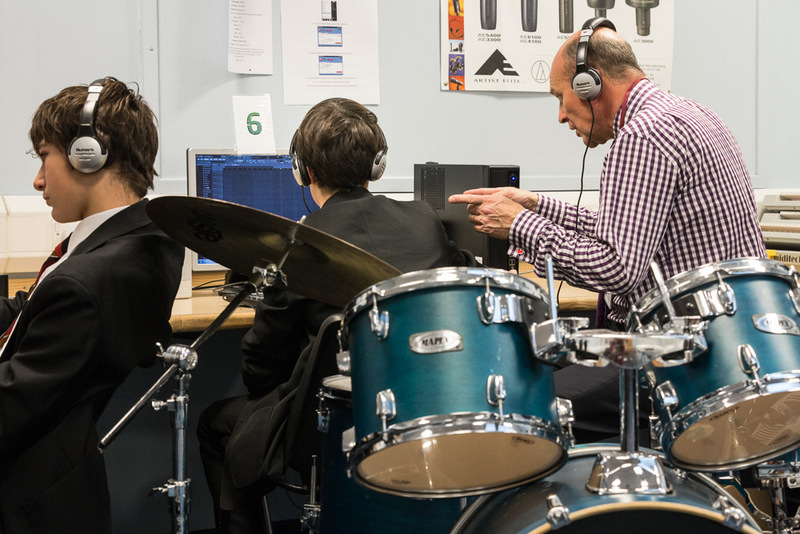
Fred Longworth High School Specifically, the Primary project that has been developed aims to provide the capacity and knowledge to address a wider issue with music participation at Primary school in the hope that students arriving in Year 7 will have had a more positive experience of music, be more engaged in music, and will have a range of instrumental skills.
What is the content of the work?
The content of Musical Futures grows from where students’ interests and passions lie musically. It involves a combination of students creating new sounds, and performing existing repertoire—notably that which students themselves have a choice over. Aural learning is the main learning style, although written material (notation, tab, graphic score) can be accessed by the students. Technology is integrated throughout Musical Futures work, as a way of creating, producing and recording sounds. Regular performance opportunities are encouraged, both to peers within the classroom and externally in assemblies, school and broader concerts. Students are able to express themselves musically, develop independent learning skills, demonstrate enjoyment, enthusiasm and interest. Cooperation, collaboration and a sense of ownership over learning that is reported to contribute to an enhanced sense of wellbeing, such as character development, self-esteem, confidence and a sense of pride in work is typically observed in a successful Musical Futures classroom.
Morpeth School
All projects are taught with the Musical Futures ethos of informal learning backed with support to progress in class and at home.
Harrogate Grammar School
Previous to Emily implementing the Musical Futures approach eight years ago when she started at the school, numbers at KS5 (ages 17-18y) were low and the curriculum followed a more formal approach. The current programme begins in Primary schools, with Emily and her team leading work, including whole class string programmes, drawing on the Musical Futures “Just Play” approach and vocal work. Many of these students will progress to Harrogate and have been exposed to the methods and styles of teaching that is to be used throughout their school music life. At KS3, students have three, fifty-five minute lessons over two weeks, in KS4 music is taught four times over two weeks, and at KS5 students have music four times a week. KS3 students follow a project-based programme of study, some of which is ICT based. This is usually done using Sibelius from a creative or practical starting point. An example of this is the Minimalism Project in Year 8, which begins with an instrumental starting point that then leads to work with repeating patterns using Sibelius.
The success of our KS5 programme has been about transforming what an A Level / KS5 student looks like. Students do not need to have followed the ‘traditional ' formal’ approach to learning in order to be successful. A number of KS5 students are popular based and have gained entrance to institutions such as Royal Northern, Guildhall School of Music and Drama, Trinity, LIPA and ACM.
Steyning Grammar School Jon structures their curriculum around broad themes from Musical Futures resources and practice at KS3, and then gives all students who opt for music a diet of both vocational and academic routes at KS4. Some students achieve both a vocational and GCSE qualification through this (around 25 students each year), and the remaining 25 will take either GCSE or a Rockschool Music Practitioner award. There is a similar offer at KS5, with around 10 taking A level, and 20 taking Music Practitioner currently. Again, a small minority will take both qualifications.
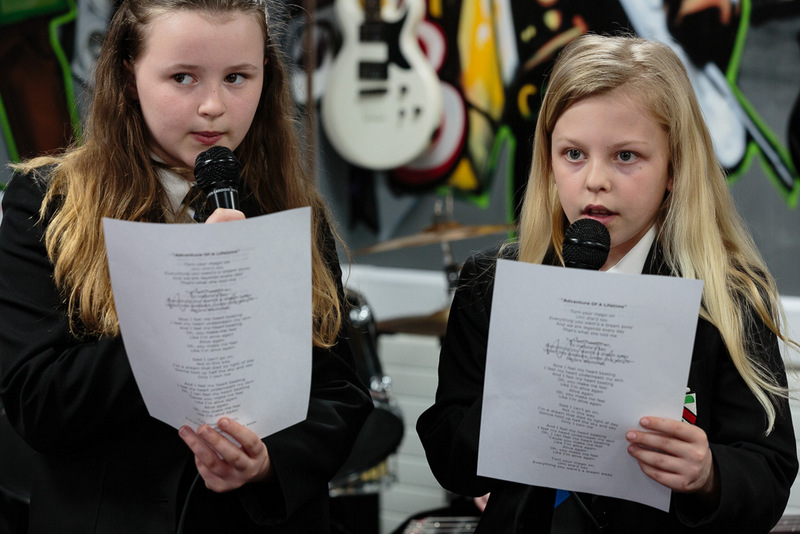
Fred Longworth High School As one of the first ‘Arts Colleges’ (designated through the Government’s Specialist Schools Initiative), Fred Longworth High School (FLHS) has been involved in working with their local Primary schools for many years. However, this approach has often resulted in staff providing PPA (timetable) cover for Primary teachers, and FLHS staff going into Primary schools to provide sessions. The Just Play approach provided an opportunity to make a sustainable shift in the teaching of music within two of local Primary schools, and to enable Primary teachers to take the lead in delivering musical sessions with their students.
What are the key features of the teaching and learning approach?
Musical Futures has a set of core principles and values about how music learning works best. In practice, this translates into a range of informal and non-formal teaching and learning strategies (all available at www.musicalfutures.org/resources).
The core values are that underpin Musical Futures are:
- Informal – led by learners with teachers/leaders modelling, guiding, supporting;
- Relevant – starts with music that learners engage and with which they identify;
- Sociable – it is collaborative and with friends;
- Inclusive – everyone takes part at their own level, working either in small groups or a whole class;
- Absorbing – learning is practical and hands-on;
- Varied – learners perform, listen, compose, improvise, work on a range of instruments and voices, use technology, explore a range of genres and styles;
- Progressive – music learning experiences are high quality, authentic where possible, and with clear progression routes;
- Respectful – all learners, no matter what their ability or experience, are treated as musicians, and are supported to learn and develop.
Morpeth School The Musical Futures Approach underpins each project in the school’s Scheme of Work for music and acts as a template for teaching and learning. There is a strong belief in the teacher providing lessons “musically” and modelling musical concepts along the way. Technology is used to support learning, including YouTube tutorials, Spotify playlists, personalized teacher websites that link to out-of-hours learning for students, DJ decks and a range of apps for recording and performing including “Accapella”(see video clip example of KS5 students), “Launchpad” “DJpro”, “GarageBand” and “Figure”.

Where possible, four learning strands (as per the Scheme of Work) are integrated into each lesson/project. Success partly lies in the fact that students make choices about their learning along the way, including who they work with, the instrument that they play and in some projects, the repertoire.
Students have the opportunity further to extend themselves by learning an instrument through the peripatetic scheme, and to have regular listening and feedback opportunities with online tasks set by each classroom teacher and the chance to join an extra-curricular ensemble.
Video Playlist
Harrogate Grammar School At the heart of teaching and learning is the idea of engaging students through a ‘hands on’ approach’, and that the teacher provides lessons ‘musically’. This means that the teacher is as much a musician as a teacher and will model through singing and playing. An informal approach is combined with supported guidance throughout with students ‘mastering the elements’ as they progress throughout the curriculum. Emily believes that it is imperative that the teacher must be demanding of students and set high expectations. “If a student is going to play a cello, then they should try to produce the best possible sound they can”. At all Key Stages, the intention is that the starting point is a musical one, with musical devices then being unpicked. There is a sense of progression designed into the music curriculum, with skills and understanding being developed as students progress, e.g., starting in Year 7 by playing three chords and then learning to transpose; this will be used again in other performance units with additional knowledge and skills being added. Notation is taught creatively through composition and performance and the more formal strands can ‘creep in’ without students knowing. At KS4 (ages 14+-16y), students all work towards ABRSM Grade 5 in their second year to bridge a gap between GCSE and A Level. Providing music in this way can offer a chance for the self-taught musician to progress and apply concepts in different ways.
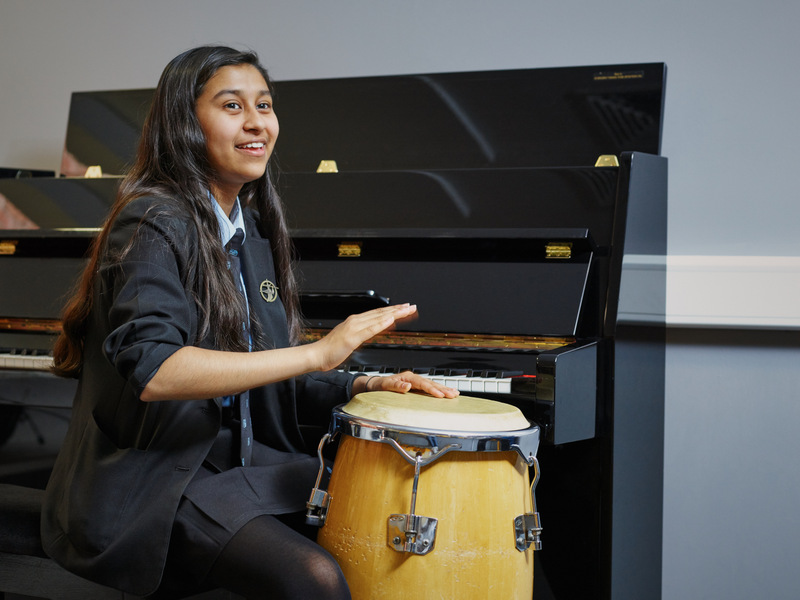
Steyning Grammar School The approach aims to be fully inclusive, growing strong all-round young musicians who are as comfortable with playing contemporary popular music as they are with studying other musics. Learning aims to be active and practical in nature, with a philosophy of meeting the needs of individuals in terms of the curriculum content. Students have their chosen route at KS4, and this principle supports the school’s mission to inspire engaged and reflective learners. Students have the opportunity further to extend themselves by learning an instrument through the peripatetic scheme, to have regular listening and feedback opportunities and the chance to join an extra-curricular ensemble.
The use of the RSL Music Practitioner suite of qualifications (https://www.rslawards.com/vocational/music-practitioners) gives stability to the use of Musical Futures. Both approaches rely on students being self motivated and engaged, and both build-in the scaffolding to support pupils to become independent learners in music. They use Google Docs and Google Classroom as a housing for this work, which has meant that feedback loops are very efficient and that progress can be pinned down thoroughly by staff and students. Jon embraces technology to facilitate this and enjoys a well-resourced and supported department.
Fred Longworth High School The work uses the Musical Futures ‘Just Play’ teaching and learning strategies, principles and materials. [ http://www.musicalfutures.org/resource-type/justplay ] This approach has been designed and tested with generalist Primary school teachers to enable them to provide whole-class music making on a range of instruments, no matter what their prior experience.
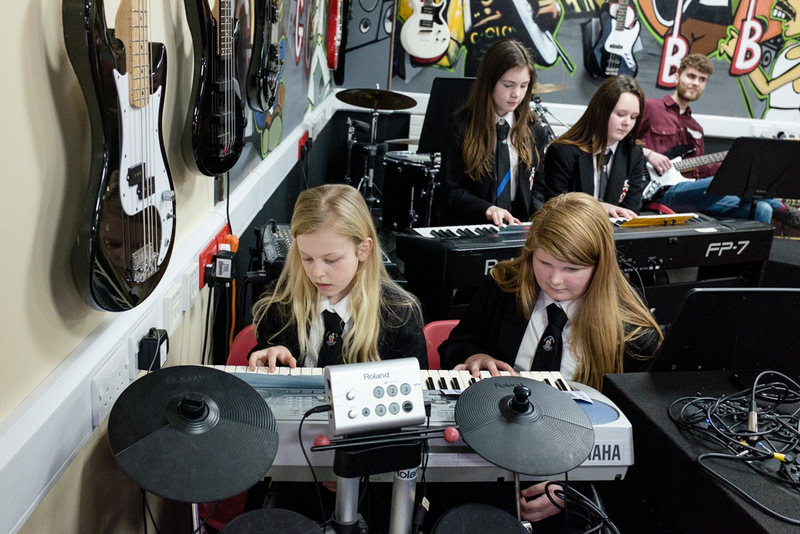
This inclusive approach, underpinned by the principles of ‘sound before symbol’ learning, have created a real energy within Fred Longworth’s feeder Primary schools – engagement among students is reported to be exceptional, and they are excited to see what impact this approach will have Fred Longworth staff’s own teaching when students arrive in Year 7.
The work of the Primary generalist teachers is supported by Lucy Dalton – Music Teacher at Fred Longworth, who has time allocated on her timetable to support local teachers.
How is the work being reviewed?
Morpeth School Technology and a dialogical approach play an important role in reviewing work. All rehearsals and performances are filmed and uploaded to a teacher’s website for students to comment on. This is used to inform both the teacher and the student on how to develop skills further. Students typically do this at the start and the end of a project, with numerous opportunities to discuss their work with the teacher and peers along the way. A written record is kept as well as video blogs.
Harrogate Grammar School The use of technology plays an important role in reviewing work and feeding back. All students have an iPad and use this extensively to evaluate and discuss their own work and that of others. Work is filmed throughout the projects in all Key Stages and quizzes are used to support feedback. Staff demand high musical values and use apps such as Kahoot and Showbe to record and feedback.
Steyning Grammar School Technology is used to gather evidence and support learning through the Google Docs platform where student work is regularly filmed and posted onto shared documents to which staff and teachers can write. This is where feedback loops are closed, and also where students learn the language of how to quantify their progress. In using the Music Practitioner qualifications, they have external validation of student progress within the Musical Futures approach as they are so closely knitted together. This provides a credible language to support their philosophy both inside and outside of school.
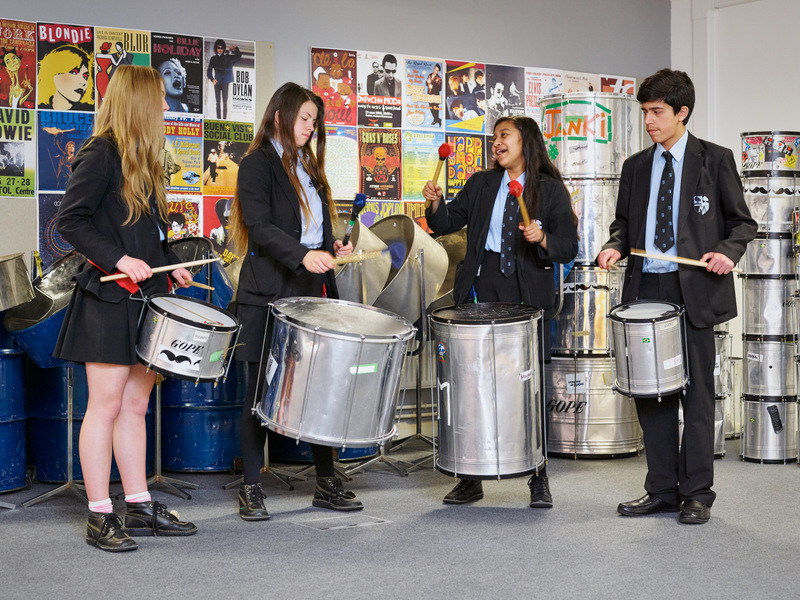
Fred Longworth High School Here the use of Musical Futures evaluation framework that surveys teachers and students before and after the activity. This information will be used when the Year 6 students arrive in Year 7 at the school.
What are the positive outcomes for children/young people – are they some or all of musical, social, personal, educational - how and when can they be identified?
Morpeth School One of the outcomes is that students report that they feel valued in their contribution to performances and creative work. Students comment on the fact that they are given choices and treated with mutual respect during lessons and also are able to follow a variety of pathways beyond KS3. These include a range of KS4 option choices that cover different learning and musical styles, taking part in ensembles and performances, instrumental tuition and forming bands and rehearsing informally. The number of students learning an instrument in school has risen in the past 10 years from 60 to around 300, with the number of students playing in ensembles also increasing.
Harrogate Grammar School The change in uptake in music has been dramatic, something Emily puts down to providing music using a Musical Futures approach. A large number of students engage in extra-curricular music, including school shows, choirs, string orchestras and jazz ensembles as well as rock bands. Students are seen to be much more independent and organise their own rehearsals during lunchtime and after school. The approach to music and its take up has created a real ‘buzz’ and sense of community in the school.
Steyning Grammar School One of the outcomes is that students report that they feel valued in their contributions to music and, as at Morpeth, they are given choices and treated with mutual respect during lessons. Choice extends to a variety of pathways beyond KS3, including diverse KS4 option choices that cover different learning and musical styles, taking part in ensembles and performances, instrumental tuition and forming bands and rehearsing informally. The number of students studying music has almost doubled at KS4 and tripled at KS5 over the last 5 years.
What are the key features of teacher/leader behaviour that are enabling those positive outcomes?
Morpeth School All teaching staff firmly believe in the benefits of providing music through the Musical Futures approach. Driving factors are in providing students with the same opportunity available to children in more affluent areas and also a belief that music makes a positive difference in young people's lives. Musical Futures offers a range of professional development opportunities ( www.musicalfutures.org/training ) with innovative ideas and a sense of community for teachers, thus providing a strong support network for sharing good practice.
The music department is fortunate to have outstanding facilities, with classrooms designed for large and small group work, rehearsal spaces and practice rooms, recording studios and ICT suites. In order to fund the work, the department has an annual budget, but also uses Pupil Premium funding (mainly for instrumental tuition), SFAG bigs, and has built strong links with manufactures and outside agencies.
Harrogate Grammar School Teachers are seen as musicians as well as teachers and are not afraid to play instruments that are not their first/main study. Teachers model musical concepts by their own musicianship and demand high musical values at all times.
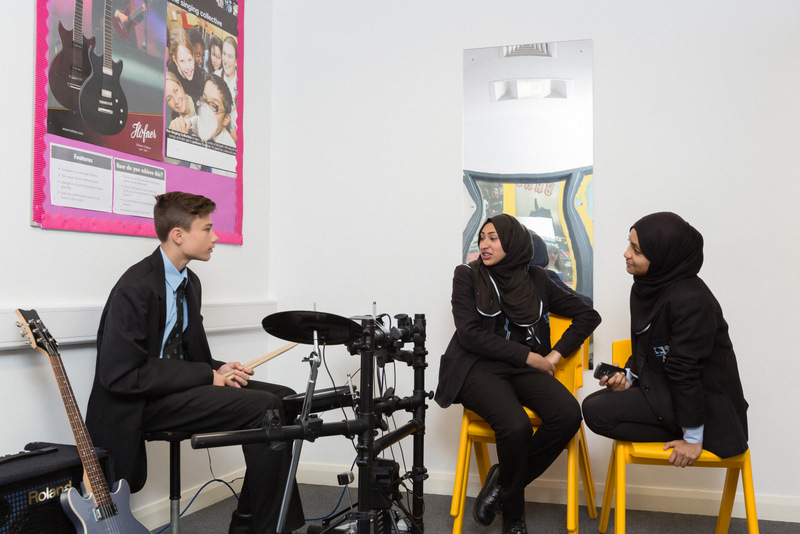
Steyning Grammar School Teachers and students learn alongside each other, have respect for a varied musical diet, and a passion for collaborative learning. Teaching staff are committed to the Musical Futures ethos and also seek to remain learners and innovators. The outward-facing work that they do in hosting staff interested in providing Music Practitioner qualifications, alongside work with Sussex University pre-service PGCE courses for intending teachers within Musical Futures ensures that staff keep abreast of change, and are open to change and development.
The department is fortunate to have good facilities, with classrooms designed for large and small group work, rehearsal spaces and practice rooms, a recording studio and an ICT suite. In order to fund the work, the department has an annual budget, but—as at Morpeth—also uses Pupil Premium funding to support instrumental tuition for less advantaged students.
What are the key features of context, content and activities that are enabling those positive outcomes?
Morpeth School Sessions begin with physical warm-ups that link to aspects of the focus project. The warm-ups help to establish foundations for the lesson, both in terms of expectations and skills and, where possible, students are given leadership opportunities to further extend their development. Being able to internalise musical parts often helps students realise the music when moving to instruments.
The sessions will either involve small group (about five per group), or whole class work, with every student having a role to play. Students will be given the opportunity to decide with whom they work and the part they play, often making decisions about the repertoire (both creative and performance).
Using technology for listening to audio tracks, students will unpick the music and use resources to help learn the parts. This encourages aural development and reading notation of some kind, with the teacher facilitating this learning. Regular feedback and filming supports progress and gives the opportunity to think about “WWW” and “EBI” (i.e., what works well and even better if). The more able are challenged with extended parts or leadership roles and often support the rest of the group.
Harrogate Grammar School Students have reasonable amounts of contact time with the classroom teacher (3 times over 2 weeks) and work is taught in a project format, with skills and concepts being built up over time. Learning is seen as ‘active’ and musical, with students being encouraged to participate in out-of-hours learning, bringing together the experiences that they have outside of the classroom to those in the lesson.

Steyning Grammar School Giving students the freedom and framework to become independent learners in music is crucial to the success of the curriculum models and seeks to ensure that all students remain engaged in school music.
What other factors in this case are contributing to those positive outcomes?
Morpeth School A level of trust and responsibility is established to help students towards achieving their potential. The department has a “departmental project manager” who organises the instrumental programme, social media and hour of hours project based work. This allows teaching staff to focus more on teaching and learning in the classroom.
Harrogate Grammar School Parental support is seen as an important factor in pupils’ musical success.
Steyning Grammar School The support of two technicians within the performing arts allows teaching staff to focus more on teaching and learning in the classroom.
How replicable or adaptable is it?
In general, the Musical Futures approach is found in many different schools and locations, both nationally and internationally and so there is evidence that it basic principles are replicable and also adaptable. At Morpeth, the programme is not genre specific and works across all age phases, as well as with technology. Harrogate regards the approach as ‘good music teaching’ and has first-hand evidence of the positive impact of the approach, including the encouragement of teachers to act as musicians with their pupils, “ Music teachers shouldn’t be afraid to sing or play for students”. Steyning reports that the approaches with older pupils are replicable in other settings, suggesting that, in more challenging schools, it could be simpler to set the different types of vocational and academic qualifications as separate options. The school reports that it benefits from a three-year KS4 design that provides additional time to explore both approaches. All case study teachers agree that the Musical Futures ethos is replicable.
